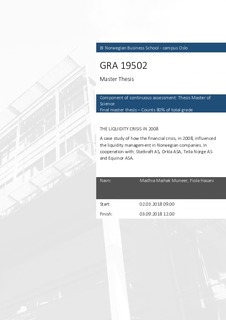THE LIQUIDITY CRISIS IN 2008 : A case study of how the financial crisis, in 2008, influenced the liquidity management in Norwegian companies. In cooperation with: Statkraft AS, Orkla ASA, Telia Norge AS and Equinor ASA
Master thesis
Permanent lenke
http://hdl.handle.net/11250/2578525Utgivelsesdato
2018Metadata
Vis full innførselSamlinger
- Master of Science [1621]
Sammendrag
The economy of the United States of America experienced a longer period of
growth and optimism around the millennium. Increased confidence in the
financial markets led to low risk aversion by the investors, while the increase
grew in line with the rising house prices. In 2008 the bubble exploded, the money
market froze and the world stood above one of the most chaotic financial periods
since the 1930s. The crisis also affected the markets in Norway; therefore, it is
appropriate to study the impact of the financial crisis on the liquidity management
of the Norwegian companies. It is this financial area that is largely reflected in the
research literature. To study how the financial crisis in 2008 has affected the
liquidity management in the Norwegian companies, we have conducted a case
study with four Norwegian companies. We chose to use interviews as method in
our case study. In this way, we have gained experiences about the impact of the
financial crisis on the companies' liquidity funds, financing, risk assessments and
changes in how the liquidity management takes place in practice.
The case study has revealed several factors that increased the focus of the
Norwegian companies after the financial crisis. The analysis shows that the
companies experienced more uncertainty compared to the banks, which were
considered less solid during the crisis. This resulted in a desire to reduce the bank
exposure and diversify the loan sources, and utilizing the internal capital to an
even greater extent. Several of the companies initiated projects of the working
capital to free up internal capital. The data collection revealed that the companies
wanted to secure a buffer in case the markets in Norway were shut down. For this
reason, several of the companies increased their facilities in the banks as an added
security. In this way, the study emphasizes the importance of credit facilities as
sources of capital from the banks in crisis such as the financial crisis in 2008.
Beskrivelse
Masteroppgave(MSc) in Master of Science in Business, Finance - Handelshøyskolen BI, 2018
